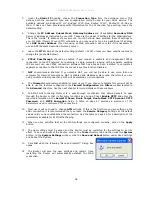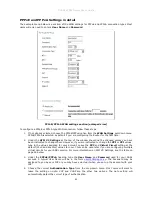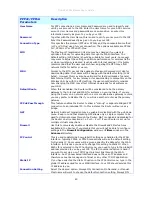
DSL-504T DSL Router User’s Guide
38
3.
Under the Static IP heading, choose the Connection Type from the pull-down menu. This
defines both the connection type and encapsulation method used for your ADSL service. The
available options are Bridged IP LLC, Bridged IP VC-Mux, Routed IP LLC, Routed IP VC-Mux or
IPoA. If have not been provided specific information for the Connection Type setting, leave the
default setting.
4.
Change the IP Address, Subnet Mask, Gateway Address and (if available) Secondary DNS
Server IP address as instructed by your ISP. These are the global IP settings for the WAN interface.
This is the “visible” IP address of your account. Your ISP should have provided these IP settings to
you. For IPoA (Classic IP over ATM) connections you may need to type in an additional IP address
for a ARP Server Address. If you are using an IPoA connection, ask your ISP if it is necessary to
use an ARP (Address Resolution Protocol) server.
5.
Leave the MTU value at the default setting (default = 1400) unless you have specific reasons to
change this (see table below).
6.
PPPoE PassThrough should be enabled if you require a separate and independent PPPoE
connection to the ISP network. For example, a single computer running with a separate exisiting
ISP account can use PPPoE connection software that has already been installed to complete a
separate connection to the ISP. Most users will leave this function Disabled.
7.
NAT should remain Enabled. If you disable NAT, you will not be able to use more than one
computer for Internet connections. NAT is enabled and disabled system-wide, therefore if you are
using multiple virtual connections, NAT will be disabled on all connections.
8.
The Firewall should remain enabled for most users. If you choose to disable this you will not be
able to use the features configured in the Firewall Configuration and Filters window located in
the Advanced directory. See the next chapter for more details on these windows.
9.
Point-to-Point Tunneling Protocol is a pass-through mechanism that allows packets to pass
through the Router so that it effectively functions as a bridge. Check Enable PPTP and enter the
required information in the ServerIP/Name, Route Target, Route Mask, PPTP Account, PPTP
Password, and MPPE Encryption fields. A table on page 47 provides a summary of the
parameters used to configure PPTP connections.
10.
Most users will not need to change ATM settings. If this is the first time you are setting up the
ADSL connection it is recommended that you leave the Service Category settings at the default
values until you have established the connection. See the table on page 44 for a description of the
parameters available for ATM traffic shaping.
11.
When you are satisfied that all the WAN settings are configured correctly, click on the Apply
button.
12.
The new settings must be saved and the Router must be restarted for the settings to go into
effect. To save and reboot the Router, click on the Tools directory tab and then click the System
button. In the System Settings window, click the Save and Reboot button under Save Settings
and Reboot the System.
13.
Click OK when the following “Save and restart?” dialog box
opens.
14.
The Router will save the new settings and restart. Upon
restarting the Router will automatically establish the WAN
connection.
Summary of Contents for DSL-504T
Page 1: ...DSL 504T ADSL Router User Guide January 2007 ...
Page 19: ...DSL 504T DSL Router User s Guide 11 Click the start installation button Click the NEXT button ...
Page 20: ...DSL 504T DSL Router User s Guide 12 Click the NEXT button Click the NEXT button ...






























